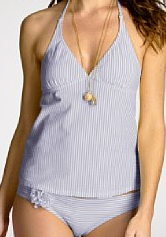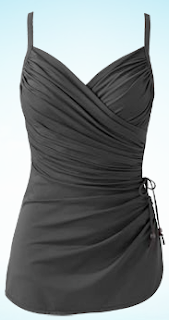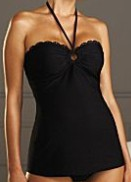There’s not a figure that the “Corolle Line” progeny does not flatter. Introduced by Christian Dior in a post-war world, the “New Look’s” goal was to amplify feminine features. Initially reinforced with abundant petticoats, the A-line skirt was streamlined by Coco Chanel in the sixties, sported sublimely by Jacqueline Kennedy, and never forgotten since.
Today, this staple holds the category of skirts (and dresses) which from a narrow waist swell to a flared hem. Its obvious name is based on its physical kinship with the letter “A.”
 Few figures benefit more from the veil of the A-line than the Lower Figure. For best results the interpretation should be dark in hue, simple in pattern, absent in pleating, and dramatic in line from hip to hem.
Few figures benefit more from the veil of the A-line than the Lower Figure. For best results the interpretation should be dark in hue, simple in pattern, absent in pleating, and dramatic in line from hip to hem.
At the opposite end of the figure spectrum, the Upper Figure benefits from the balancing effect of the A-line silhouette. The flared hem creates symmetry with a broader shoulder and/or bust. The ideal drape sports a bold color, pattern, and/or embellishment. Each component brings attention and proportional volume to a slim second half.
The Linear Figure’s A-line skirt should mimic volume. The fabric should be fluid and the embellishments should be curvaceous. A strong high waistband and generous amount of pleating magnify feminine contours.
For optimum Middle Figure flattery focus should be given to a flexible waistband. Rather than stiff and structured, opt for zipper-less pull-on styling that secures the waist without squishing your soft delicious center. Pair with a finished-hem top and avoid tucking at all costs.
 The narrowed center of an Hourglass should be tenderly embraced whenever possible. A high, structured waist will appropriately hug the core, while a full, pleated skirt will emphasize indigenous curves, resulting in an intensified silhouette. For additional dramatics, tuck your blouse into your waistline.
The narrowed center of an Hourglass should be tenderly embraced whenever possible. A high, structured waist will appropriately hug the core, while a full, pleated skirt will emphasize indigenous curves, resulting in an intensified silhouette. For additional dramatics, tuck your blouse into your waistline.









